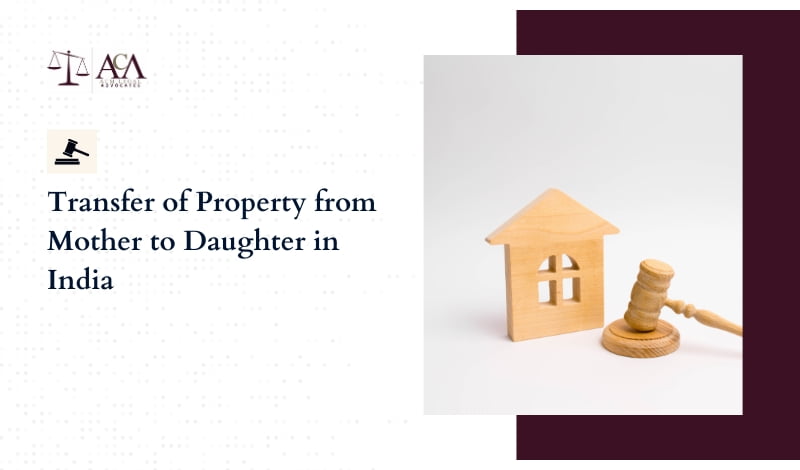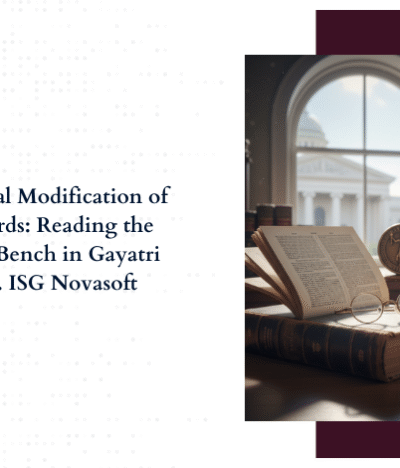Can a mother transfer property to her daughter in India? Yes, the transfer of property from a mother to a daughter is a common practice in India and can be done through various legal means. The transfer of property from mother to daughter can be accomplished through various legal methods such as gift deeds, sale deeds, wills or intestate succession. Each method involves specific legal formalities, documentation and compliance to ensure the transfer is valid and binding.
Each method has its own set of legal nuances and documentation requirements, making it essential to be well-informed or seek professional legal advice to navigate the process effectively.
Transfer of Property from Mother to Daughter in India
How to transfer property from mother to daughter in India involves various methods such as drafting a gift deed, sale deed, will, or through intestate succession. Each method entails adherence to specific legal formalities, including documentation, stamp duty payments, and registration at the sub-registrar office. These steps ensure the legality and validity of the transfer of property from mother to daughter, safeguarding the interests of both parties involved.
1. Transferring Property Through a Gift Deed
One common method to transfer property from mother to daughter in India is through a gift deed. This involves the mother (donor) transferring ownership to the daughter (donee) without any monetary exchange.
1.1. Drafting the Gift Deed
The gift deed must be carefully drafted, detailing the specifics of the property, the donor and the donee. It should explicitly state that the transfer is a gift and does not involve any consideration.
1.2. Acceptance by the Donee
For the gift deed to be valid, the daughter (donee) must accept the gift during the lifetime of the mother (donor).
1.3. Stamp Duty
The stamp duty for registering a gift deed varies across different states in India. When transferring property from mother to daughter, certain states offer concessional rates for stamp duty.
For instance, in Haryana, the stamp duty for gifting property to immediate family members is capped at 6%.
In Delhi, the rate is 4% of the circle rate if the donee is a woman, 6% if the donee is a man, and 5% if the property is jointly held.
1.4. Registration
Both the mother and daughter must appear at the sub-registrar’s office with two witnesses to register the gift deed. Required documents include the original gift deed, identity proofs (such as Aadhaar and PAN cards) and the original property documents. Registration fees also vary by state.
1.5. Required Documents
- Drafted Gift Deed
- Identity Proofs
- Original Property Documents
- Encumbrance Certificate
- No Objection Certificate (if applicable)
- Proof of Payment of Stamp Duty
2. Transferring Property Through a Sale Deed
Another method to transfer property from mother to daughter in India is through a sale deed, where ownership is transferred in exchange for monetary consideration.
2.1. Agreement to Sell
Before drafting the sale deed, both the mother and daughter must agree on the sale terms, including the sale price and any conditions. This agreement should detail the property description and the sale considerations.
2.2. Drafting the Sale Deed
The sale deed is a legal document transferring ownership from the seller (mother) to the buyer (daughter). It should include:
- Details of both parties (mother and daughter)
- Description of the property
- Sale consideration (price)
- Mode of payment
- Transfer of rights, title, and interest
- Date of possession transfer
2.3. Execution of the Sale Deed
Both parties must sign the sale deed in the presence of at least two witnesses at the concerned sub- registrar’s office.
2.4. Payment of Stamp Duty and Registration Fees
The buyer (daughter) is generally required to pay the stamp duty and registration fees. These amounts depend on the property’s location and value and are paid at the local sub-registrar’s office.
2.5. Registration of the Sale Deed
To finalize the sale deed, it must be registered with the local sub-registrar. Both parties, along with the witnesses, need to be present with the following documents:
- Signed sale deed
- Identity proofs (e.g., Aadhaar card, PAN card)
- Passport-sized photos
- Proof of stamp duty and registration fee payment
- Previous property title documents
- Encumbrance certificate
2.6. Mutation of Property
After the sale deed is registered, the daughter should apply for the mutation of the property in the local municipal records to update the ownership details.
3. Transfer of Property via Succession
Property can also be transferred from mother to daughter through succession, either by testamentary succession (via a will) or intestate succession (without a will).
3.1. Testamentary Succession
Testamentary succession involves the transfer of property according to the deceased mother’s will, as per the Indian Succession Act, 1925.
3.1.1 The Will
A will should clearly express the mother’s intention to transfer the property to her daughter upon her death. It must include:
- Detailed description of the property
- Names of all beneficiaries
- Specific shares each beneficiary will receive (if there are multiple beneficiaries)
The will must be signed by the mother in the presence of at least two witnesses, who also sign the document to attest its authenticity.Although not mandatory, registering the will with the sub-registrar can provide additional legal security and reduce the risk of future disputes.
3.1.2. Declaration of Title Suit
The daughter may file a suit in civil court to assert her right to the property, providing documentary evidence such as the will and other relevant documents. The court examines the evidence, and if satisfied, may issue a declaration affirming her title to the property.
3.1.3. Probate Process (If Required)
In certain cities like Mumbai, Chennai, and Kolkata, probate of a will is mandatory. The executor named in the will files a petition for probate. The court verifies the will, and if valid, grants probate, allowing the executor to distribute the property according to the will.
3.1.4. Mutation of Property
To update the property records, the daughter should submit an application for mutation to the local municipal or revenue office.
3.1.5. Required Documents
- Drafted Will
- Death Certificate
- Identity Proofs
- Witnesses’ Identity Proofs
- Executor’s Identity Proof
- Property Documents
- Legal Heir Certificate
- Succession Certificate (if applicable)
- Any Other Relevant Documents
3.2. Intestate Succession (Without a Will)
Intestate succession applies when the mother passes away without leaving a valid will. In such cases, the distribution of the deceased’s property is governed by the relevant personal laws.
3.2.1. Identifying Legal Heirs
The first step is to identify the legal heirs based on the personal laws applicable to the deceased’s religion. For example, under the Hindu Succession Act, legal heirs typically include the spouse, children (both sons and daughters), and parents.
3.2.2. Obtaining a Legal Heir or Succession Certificate
The legal heirs must obtain a legal heir certificate or succession certificate from the relevant authority. This certificate serves as proof of their entitlement to the deceased’s assets. The application process usually requires submitting the death certificate, proof of relationship with the deceased and other relevant documents.
3.2.3. Verification and Issuance of Certificate
The relevant authority verifies the submitted documents to confirm the claim of the legal heirs. Upon satisfactory verification, the authority issues the legal heir or succession certificate.
3.2.4. Partition of Property
In the case of a Hindu female who dies intestate, the property succession follows a specific order as per Section 15. Firstly, the property devolves upon her sons and daughters and her husband. If these claimants are absent, the property then devolves upon the heirs of the husband. In the absence of the husband’s heirs, the mother and father of the deceased female inherit the property. If the mother and father are also absent, the property goes to the heirs of the father, and lastly, if none of these claimants are available, the property devolves upon the heirs of the mother. This structured hierarchy ensures an orderly succession process for a Hindu female’s property.
3.2.5. Mutation of Property Titles
After partitioning, the legal heirs must initiate the mutation process to transfer property titles to their names. This involves submitting the legal heir certificate and other relevant documents to the local municipal authority.
3.2.6. Transfer of Possession and Ownership
Once the mutation process is complete, the legal heirs, including the daughter, become the rightful owners of their respective shares of the deceased mother’s property.
3.2.7. Required Documents
- Death Certificate
- Legal Heir Certificate
- Identity Proofs
- Property Documents
- Affidavit (if required)
- Succession Certificate (if applicable)
- Any Other Relevant Documents
Common Challenges of Transferring Property Mother to Daughter
Transfer of property from a mother to daughter is a significant undertaking often accompanied by various challenges as follows:
Incomplete or Incorrect Documentation
Incomplete or incorrect documentation poses a significant challenge during property transfer processes. When essential documents are missing or contain errors, it can stop the process of transfer. For example, if a property deed is missing or if identification documents are outdated, the legal validity of the transfer can be questioned. Similarly, incomplete legal heir certificates can lead to disputes over rightful ownership. It’s crucial to ensure that all necessary documents are gathered, verified, and updated.
Verification of Title
Verifying the title of a property is another critical challenge in the transfer process. A clear title is essential to establish legal ownership and ensure that the property can be transferred without any encumbrances or disputes. However, issues such as unpaid property taxes, unregistered transfers or conflicting claims can complicate the verification process. To address this challenge, it’s necessary to conduct a thorough title search.
Will Disputes
Disputes over wills can also pose significant challenges during property transfers, particularly if other legal heirs contest the validity of the will. Common issues that may arise include claims of undue influence, questions about the testator’s mental state or allegations of forgery. It’s essential to ensure that the will is properly drafted and registered.
Stamp Duty and Registration Fees
Stamp duty and registration fees present variable costs that can significantly impact the overall cost of property transfer. These fees vary between states and can be substantial, potentially reaching up to 7% of the property’s market value in some regions. Delays or errors in paying these fees can also result in penalties.
Conclusion
Successfully transferring property from mother to daughter in India requires careful attention to legal procedures and awareness of potential challenges. Whether through a gift deed, sale deed, or succession, the process demands strict adherence to legal requirements.
Explore Property Transfer Solutions with ACM Legal
Navigating the complexities of property transfer requires personalized legal advice. Consulting with legal professionals ensures a comprehensive understanding of legal requirements and facilitates a smooth transfer process. At ACM Legal, our team of experts offers specialized guidance to address unique needs and concerns.
FAQs
1. How to transfer property from mother to daughter in India?
In India, property can be transferred from a mother to a daughter through several methods such as a gift deed, sale deed, or succession. A gift deed involves transferring the property without any monetary exchange, while a sale deed involves a financial transaction. In the case of succession, the property is transferred according to the mother’s will or, if there is no will, through intestate succession laws. All methods require compliance with legal documentation and registration.
2. What legal procedures must be followed for transferring property from a mother to a daughter in India?
The transfer of property from mother to daughter involves legal procedures including drafting the relevant deed (gift or sale), payment of applicable stamp duty, and registering the deed at the sub-registrar’s office. In the case of a will, the will must be validated and a succession or legal heir certificate may be required if the mother dies intestate. All necessary documents, such as identity proofs, property documents and proof of payment of stamp duty, must be provided.
3. What documents are required for transferring property from a mother to a daughter?
The required documents typically include:
- Drafted Gift Deed or Sale Deed
- Identity Proof (Aadhaar, PAN card)
- Property Documents
- Encumbrance Certificate
- No Objection Certificate (if applicable)
- Proof of Payment of Stamp Duty
- Death Certificate (for succession)
- Legal Heir Certificate or Succession Certificate (if applicable)
- Will (if applicable)
- Witnesses’ Identity Proofs (for wills)
4. How does property transfer work if there’s no will?
If there is no will, the property is transferred according to the intestate succession laws applicable to the deceased’s religion. For Hindus, the Hindu Succession Act applies, and the property is divided among the legal heirs, including the spouse and children. Legal heirs must obtain a legal heir or succession certificate to establish their right to the property and initiate the mutation process to transfer property titles.
5. What are the common challenges in transferring property from mother to daughter?
Common challenges include:
- Legal Formalities and Documentation
- Family Disputes
- Succession Laws and Inheritance Rights
- Stamp Duty
- Fraudulent Practices and Documentation
Explore More Property Transfers
- Father to Son
- Father to Daughter
- Mother to Son
- Husband to Wife
- Wife to Husband
- Father in Law to Son in Law
- Father in Law to Daughter in Law
- Mother in Law to Son in Law
- Mother in Law to Daughter in Law
- Grandfather to Grandson
- Grandmother to Grandson
- Brother to Brother
- Brother to Sister
- Sister to Brother






